
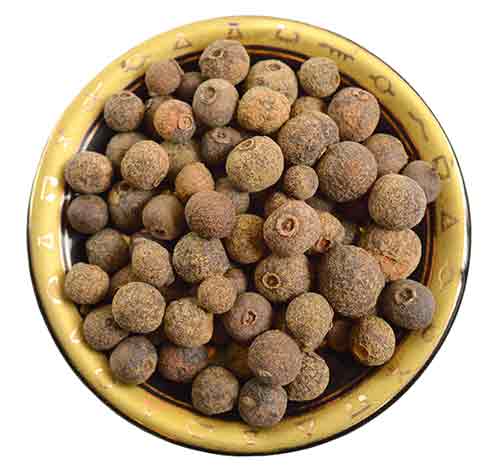
Cambria Heights
218-13 Linden Boulevard, Cambria Heights
Jamaican Allspice
Allspice is a tropical evergreen tree (Pimenta diocia, formerly P. officinalis) of the myrtle family (Myrtaceae), native to the West Indies and Central America and valued for its berries, the source of a highly aromatic spice. Allspice was so named because the flavour of the dried berry resembles a combination of cloves, cinnamon, and nutmeg. It is widely used in baking and is usually present in mincemeat and mixed pickling spice. Early Spanish explorers, mistaking it for a type of pepper, called it pimenta, hence its botanical name and such terms as pimento and Jamaica pepper. The first record of its import to Europe is from 1601.
Source: Encyclopedia Britannica
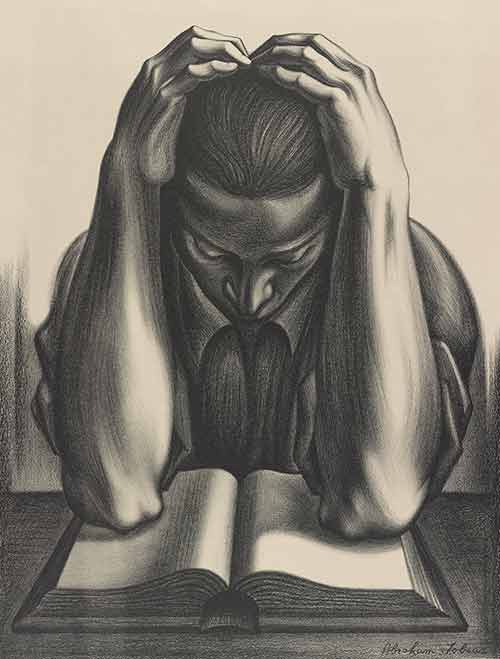
Central
89-11 Merrick Boulevard, Jamaica
The Reader (1937-1942)
Abraham Joel Tobias
Man, holding his head with his hands, reading a book, at a table. He holds the book open with his elbows.2
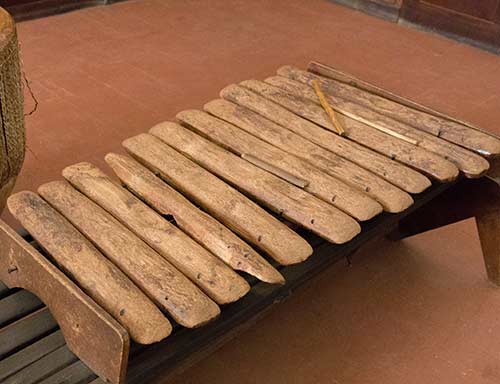
Corona
38-23 104 Street, Corona
Marimba
Marimba is one of many African names for the xylophone, and, because African instruments bearing this name frequently have a tuned calabash resonator for each wooden bar, some ethnomusicologists use the name marimba to distinguish gourd-resonated from other xylophones. The xylophone was taken to Latin America by African slaves (or possibly originated through pre-Hispanic contact). There it became known as the marimba, and it has remained a popular folk instrument in Central America. The wooden bars are affixed to a frame supported by legs or hung at the player’s waist. Large, deep-toned instruments up to 6 1/2 octaves in range are sometimes played by four musicians. Marimba keys have tubular or gourd resonators, and, as in Africa, a buzzing membrane is frequently set in the resonator wall, adding a sharp edge to the instrument’s sound.
Source: Encyclopedia Britannica
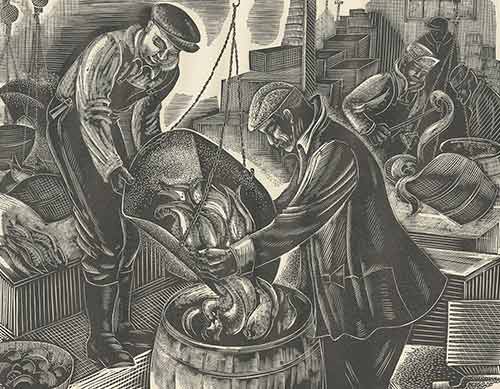
Court Square
25-01 Jackson Avenue, Long Island City
Weighing Fish (1937-1942)
M. Lois Murphy
Men weighing fisherman’s catch on a scale.1
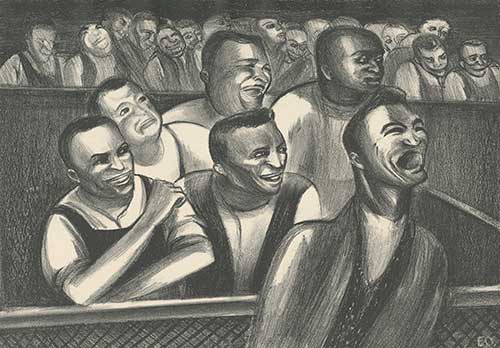
Douglaston-Little Neck
249-01 Northern Boulevard, Little Neck
W.P.A. Entertainment for the Seamen (1935-1943)
Elizabeth Olds
Seamen gathered in a box seat being entertained during a performance. One of the men is visibly laughing.1
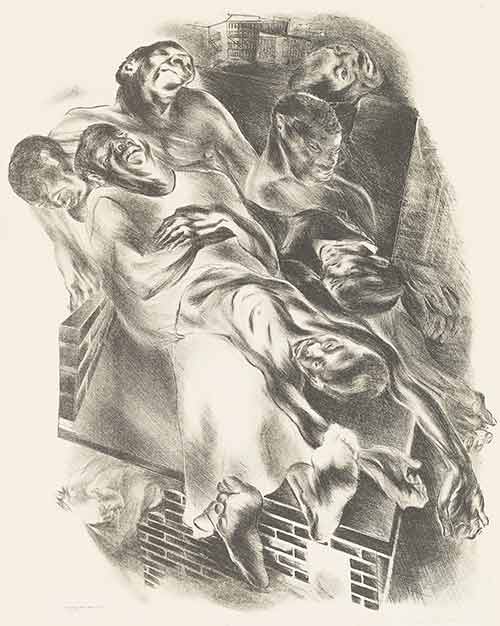
East Flushing
196-36 Northern Boulevard, Flushing
Harlem (1937-1942)
Nan Lurie
Harlem residents sleeping on the rooftop of a building.1
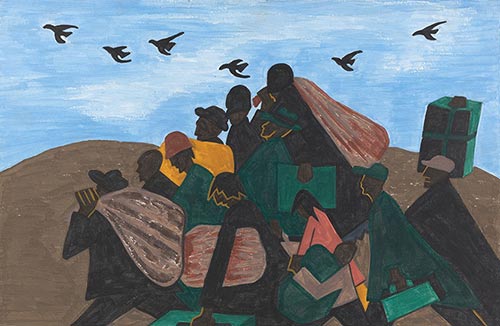
Elmhurst
86-07 Broadway, Elmhurst
The Migration Series Panel 3 (1940-41)
Jacob Lawrence
This is a panel from Jacob Lawrence's Migration Series. The caption reads, "From every southern town migrants left by the hundreds to travel north."
Almost 80 years ago, young artist Jacob Lawrence set to work on an ambitious 60-panel series portraying the Great Migration, the flight of more than a million African Americans from the rural South to the industrial North following the outbreak of World War I. Before painting the series, Lawrence researched the subject and wrote captions to accompany each panel. Like the storyboards of a film, he saw the panels as one unit, painting all 60 simultaneously, color by color, to ensure their visual unity. The poetry of Lawrence's epic statement emerges from its staccato-like rhythms and repetitive symbols of movement: the train, the station, ladders, stairs, windows, and the surge of people on the move. Following the example of the West African storyteller, who spins tales of the past that have meaning for the present and the future, Lawrence tells a story that reminds us of our shared history and at the same time invites us to reflect on the universal theme of struggle in the world today.
Source: The Phillips Collection phillipscollection.org3
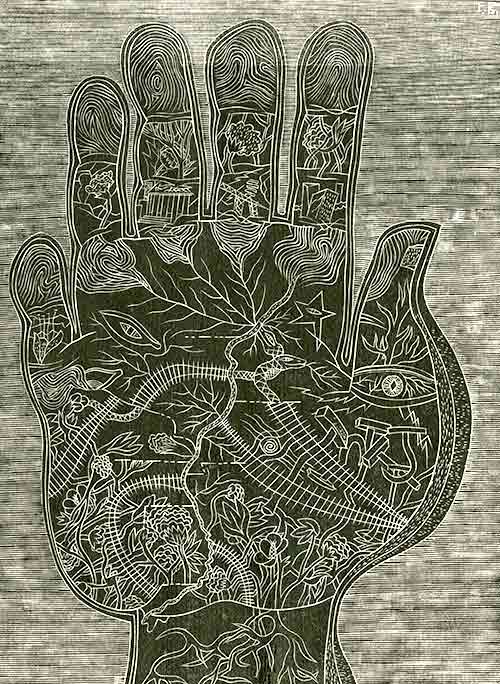
Far Rockaway (Temporary Location)
1003 Beach 20th Street, Far Rockaway
John Henry’s Hand (1935)
Fred Becker
John Henry’s palm engraved with etchings of railroad lines and other symbols.1
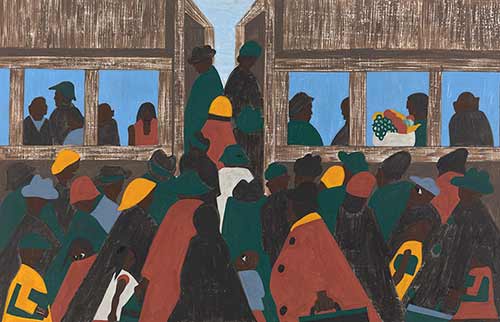
Flushing
41-17 Main Street, Flushing
The Migration Series Panel 23 (1940-41)
Jacob Lawrence
This is a panel from Jacob Lawrence's Migration Series. The caption reads, "The Great Migration spread."
Almost 80 years ago, young artist Jacob Lawrence set to work on an ambitious 60-panel series portraying the Great Migration, the flight of more than a million African Americans from the rural South to the industrial North following the outbreak of World War I. Before painting the series, Lawrence researched the subject and wrote captions to accompany each panel. Like the storyboards of a film, he saw the panels as one unit, painting all 60 simultaneously, color by color, to ensure their visual unity. The poetry of Lawrence's epic statement emerges from its staccato-like rhythms and repetitive symbols of movement: the train, the station, ladders, stairs, windows, and the surge of people on the move. Following the example of the West African storyteller, who spins tales of the past that have meaning for the present and the future, Lawrence tells a story that reminds us of our shared history and at the same time invites us to reflect on the universal theme of struggle in the world today.
Source: The Phillips Collection phillipscollection.org3

Forest Hills
108-19 71 Avenue, Forest Hills
What We Bring: The Cajón
Héctor Morales
“My relationship with Afro-Peruvian and Creole music started since the day I was born. This was the music my father loved and the music he played for us at home.”9
1 Courtesy of the Fine Arts Collection, U.S. General Services Administration Federal Art Project NYC WPA. On extended loan to Queens Library. Contact digitalarchives@queenslibrary.org for research and reproduction requests.
2 Courtesy of the Fine Arts Collection, U.S. General Services Administration New Deal Art Project. On extended loan to Queens Library. Contact digitalarchives@queenslibrary.org for research and reproduction requests.
3 1940–41, Casein tempera on hardboard, 12 x 18 in. The Phillips Collection, Washington, DC, Acquired 1942. phillipscollection.org.
4 1940–41, Casein tempera on hardboard, 12 x 18 in. The Museum of Modern Art, New York. Gift of Mrs. David M. Levy.
5 Courtesy of the Fine Arts Collection, U.S. General Services Administration New York City WPA Art Project. On extended loan to Queens Library. Contact digitalarchives@queenslibrary.org for research and reproduction requests.
6 Courtesy of the Queens Library, Archives, Storefront Museum Collection.
7 This replica of Augusta Savage’s The Harp is part of the Langston Hughes Community Library’s Black Heritage Reference Center.
8 Harvey Wang, Courtesy of the Queens Library, Archives, Queens Council on the Arts Collection. Copyright: Harvey Wang.
9 Courtesy of City Lore, What We Bring: Immigrant Gifts exhibit, on view at Central Library until March 2. Cosponsored by City Lore, Center for Traditional Music and Dance, the Brooklyn Arts Council, and the CATCH consortium. Curated by Tom Van Buren and Steve Zeitlin. Funded by the Andrew W. Mellon Foundation with additional support from the New York State Council on the Arts and the NYC Department of Cultural Affairs. Photography by Tom Pich.
10 Queens Library, Archives, Queens Borough Public Library Photographs.
11 Courtesy of the Queens Library, Archives, Frederick J. Weber Photographs. Copyright: Estate of Frederick J. Weber.